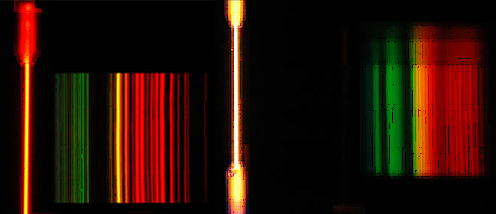Download this activity in PDF format (complete with illustrations)
Materials
- a cereal box
- diffraction grating
- a pair of scissors
- a roll of tape
- a pen
Step 1
Select one end of the cereal box, and close the flaps. Place a diffraction grating on this end and outline it with the sharpie. This will be referred to as the front of your "Spectroscope". (Note: Diffraction gratings can be obtained from various educational science resource stores)
Step 2
Open the flaps and cut a hole smaller than the size of your outline in the cereal box. If the spectral lines are not vertical, like the picture below, you need to turn the grating 90 degrees.
Step 3
Tape the cereal box flaps closed. Arrange your diffraction grating right side up (so you can read the label), then tape it over the hole you just cut. Make sure you can look through the grating and see inside the box.
Step 4
Rotate the box around so you are now looking at the opposite end. (This will be the back of your ?Spectroscope?). Close the two flaps and draw a line down the center (top to bottom, not side to side). The line should be directly opposite the diffraction grating, and centered. Step 5
Cut along the mark you just made, making a very, very narrow slit in the box.
Step 6
Close and tape the flaps on the back of your box. You point the slit at the light source and the spectral lines are projected onto the SIDE of the box.
You're done! Look through the grating in your spectroscope to see the light spectrum!


Extending the Activity
To Do and Notice
Compare the spectra of various lightsources. When you view different light sources, look for specific colors and notice the spacing between the colored lines. The heated tungsten filament of an incandescent light bulb produces a continuous spectrum, where one color shades into another. The electrically excited mercury vapor in a fluorescent bulb produces distinct colored lines; the phosphors that coat the inside of the bulb produce a continuous spectrum.
Some other suggested light sources are a candle flame, the flame from a Bunsen burner, a flashlight, a Coleman lantern, yellow street lights (sodium produces the color), blue street lights (mercury vapor produces the color), neon signs, and slide projector lamps.
Different light sources produce different spectra. You can see the solar spectrum by looking at sunlight reflecting off a piece of white paper. DO NOT LOOK DIRECTLY AT THE SUN! What's going on?
When atoms of different materials are excited by an electric current or other source of energy, they glow with a unique spectrum. Atoms of different elements have different colors in their spectra. These characteristic color patterns represent specific atoms, just as fingerprints serve to identify different people.
A diffraction grating acts like a prism, spreading light into its component colors. The light that you see from a light source is the sum of all these colors. Each color corresponds to a different frequency of light. The diffraction grating sorts light by frequency, with violet light (the highest frequency of visible light) at one end of the spectrum and red light (the lowest frequency of visible light) at the other.
When atoms in a dilute gas (like the mercury vapor in a mercury street light) radiate light, the light can be seen through a diffraction grating as a line spectrum, made up of bright lines of color. Each line in the spectrum of such a gas corresponds to one frequency of light emission, and is produced by an electron changing energy levels in the atom.
In solids, liquids, and densely packed gases, the situation is not so simple. As an atom emits light, it collides with other atoms. This changes the frequency of the light it emits. That's why solids, liquids, and dense gases have broad bands of light in their spectra.
Credit: The Exploratorium


